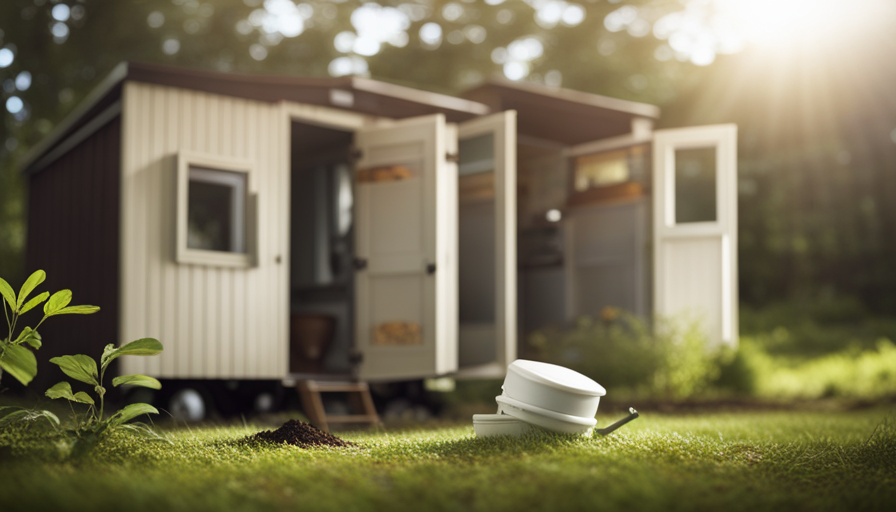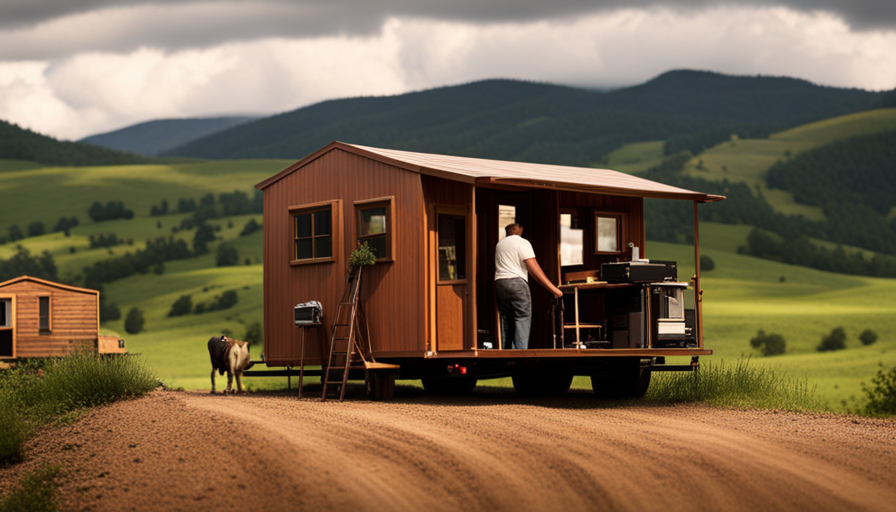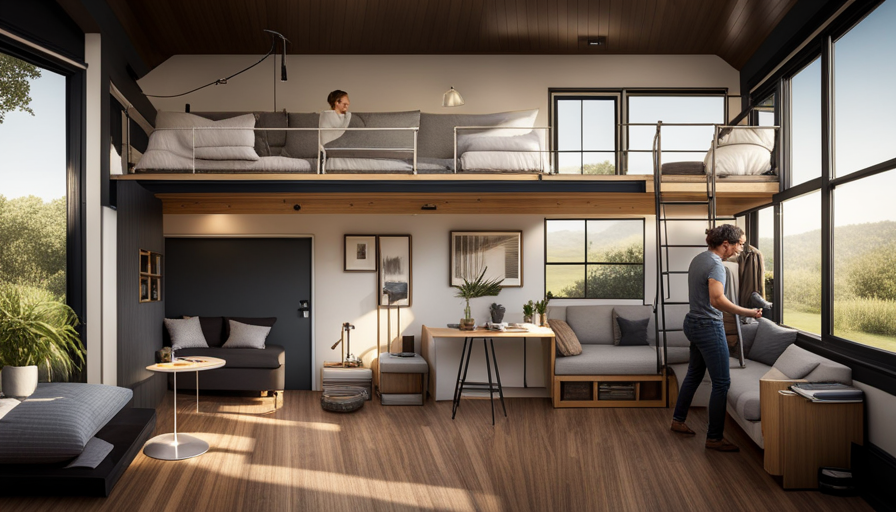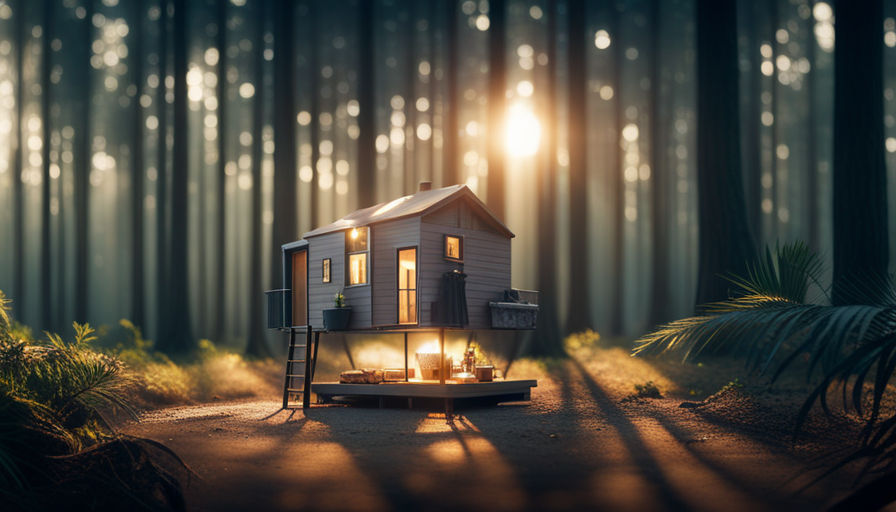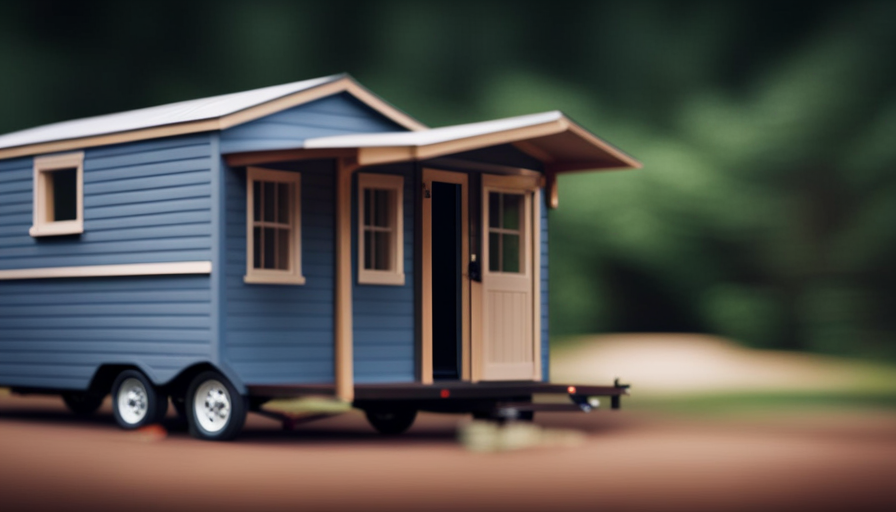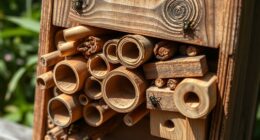Ever thought about how a composting toilet operates in a small house?
Well, let me tell you, it’s like a breath of fresh air! Like a secret garden hidden within the walls of your humble abode, a composting toilet is a sustainable and efficient solution for managing waste in a compact space.
In this article, we will explore the inner workings of composting toilets, the components that make them tick, and how they effectively manage waste. We will also delve into the maintenance and odor control aspects, as well as the advantages and disadvantages of incorporating a composting toilet in your tiny house.
But fear not, dear reader, for we shall not leave you hanging in the midst of decision-making! We will provide you with tips on choosing the right composting toilet for your tiny house and give you some practical advice on its usage. And finally, we will debunk common myths and misconceptions surrounding composting toilets.
So, let us embark on this journey of discovery and find out how a composting toilet can revolutionize the way we handle waste in our tiny houses!
Key Takeaways
- Composting toilets are a sustainable and efficient solution for waste management in tiny houses, reducing water usage and eliminating the need for a septic system or sewage connection.
- Adequate ventilation and the use of composting materials like peat moss or sawdust help manage odor and ensure proper functioning.
- Regular maintenance, such as adding bulking material and emptying the compost, is necessary for odor control and optimal functionality.
- Composting toilets significantly reduce water usage compared to traditional flush toilets, saving money in the long run and contributing to sustainable waste management.
The Basics of Composting Toilets
If you’re living in a tiny house and want to reduce your environmental impact, composting toilets are a great option for efficiently converting human waste into nutrient-rich compost. Composting toilets offer several benefits, including reducing water usage and eliminating the need for a septic system or sewage connection.
Installing a composting toilet is relatively simple and can be done in a few steps. First, choose a suitable location for the toilet that allows for proper ventilation and easy access. Next, install the toilet according to the manufacturer’s instructions, ensuring that it’s securely attached and sealed. Finally, add a composting medium, such as sawdust or coconut coir, to the toilet to aid in the decomposition process.
With these basic steps, you can have a functioning composting toilet in your tiny house.
Now, let’s delve into the components of a composting toilet.
Components of a Composting Toilet
To fully understand the inner workings of a composting toilet in your cozy abode, let’s delve into the various components that make this innovative system tick. Here are three key components that you need to know about:
-
Composting Chamber: This is where the magic happens. It’s a sealed container where waste and organic material decompose, aided by bacteria and other microorganisms. Proper ventilation ensures that odor is minimized.
-
Separator: To prevent liquids from mixing with solids, a separator is installed. It allows urine to be diverted to a separate container or drain, while solids remain in the composting chamber. This separation helps with the composting process and reduces moisture content.
-
Ventilation System: A composting toilet requires adequate ventilation to ensure proper air circulation and aerobic decomposition. This is typically achieved through a fan or vent pipe, which helps control odor and provide oxygen to the composting chamber.
With these components in place, composting toilets can effectively manage waste and meet composting toilet regulations. Now, let’s explore how these toilets handle waste management without compromising hygiene or the environment.
How Composting Toilets Manage Waste
The composting chamber of a composting toilet is like a miniature ecosystem, with waste and organic material decomposing with the help of bacteria and microorganisms, creating a natural cycle of transformation and renewal. The composting toilet installation includes various components that aid in managing waste effectively. One key component is the separator, which separates solid waste from liquid waste, preventing the mixture that causes odors. The solid waste then goes into the composting chamber, where it is mixed with bulking material like sawdust or coconut coir. This material helps absorb moisture, adds carbon to the mixture, and provides air circulation. The bacteria and microorganisms in the chamber break down the waste through aerobic decomposition. The liquid waste is diverted into a separate container or leach field. The composting toilet benefits are numerous, including reducing water usage, producing nutrient-rich compost, and being suitable for off-grid living. To maintain odor control and ensure proper functioning, regular maintenance, such as adding bulking material and periodically emptying the compost, is necessary.
Maintenance and Odor Control
When it comes to maintaining a composting toilet in my tiny house, there are three key points I need to keep in mind. First, I need to regularly empty and clean the collection chamber to ensure proper functioning and prevent any potential issues.
Second, I must manage odor by ensuring proper ventilation and using the right composting materials.
Lastly, I need to be proactive in maintaining a healthy balance of moisture and carbon in the composting process to prevent any unpleasant smells and promote efficient decomposition.
By following these steps, I can ensure my composting toilet remains clean and odor-free in my tiny house.
Emptying and Cleaning the Collection Chamber
Maintaining a composting toilet in a tiny house is a breeze with its easy-to-empty and clean collection chamber. When it comes to emptying the chamber, the process is straightforward. First, I remove the container from the toilet and take it to an outdoor composting area. Next, I carefully empty the contents into a compost bin or pile.
It’s important to follow proper composting guidelines, such as adding a balanced mixture of carbon-rich and nitrogen-rich materials. This helps to create the ideal environment for decomposition and minimizes odor. After emptying, cleaning the collection chamber is a simple task. I use a mild, eco-friendly cleaning solution and a brush to scrub the surfaces.
Regular maintenance and cleaning ensure that the composting toilet continues to function effectively. By managing odor with proper ventilation and composting materials, the composting toilet remains a hassle-free solution for waste management in my tiny house.
Managing Odor with Proper Ventilation and Composting Materials
To ensure your composting toilet remains odor-free, proper ventilation and the use of the right composting materials are essential.
Ventilation techniques play a crucial role in managing odor in a tiny house. Installing a vent fan or a small window near the toilet can help remove unpleasant odors and promote air circulation.
Additionally, using a composting material such as peat moss, coconut coir, or sawdust can aid in odor control. These materials absorb moisture and help break down the waste, reducing odor. It’s important to regularly add a thin layer of composting material after each use to maintain a healthy composting process.
By implementing these ventilation techniques and using the appropriate composting materials, you can effectively manage odor in your composting toilet.
Now, let’s explore the advantages of composting toilets in tiny houses.
Advantages of Composting Toilets in Tiny Houses
One of the biggest advantages of using a composting toilet in my tiny house is that it significantly reduces water usage compared to traditional flush toilets. This cost-effective and environmentally sustainable solution is perfect for a small space like my tiny house. With a composting toilet, I don’t need to worry about installing plumbing or connecting to a sewage system, which saves me a lot of money in the long run.
Additionally, composting toilets help to reduce the amount of waste that goes into landfills, making them an eco-friendly choice. They also produce nutrient-rich compost that can be used in my garden, further enhancing the sustainability of my tiny house lifestyle.
However, before deciding on a composting toilet, there are a few disadvantages and considerations that I should keep in mind.
Disadvantages and Considerations
Although there are some drawbacks and factors to consider, using a composting toilet in my compact dwelling offers numerous advantages. However, it’s important to acknowledge the disadvantages and environmental impact of composting toilets. One of the main concerns is the potential odor that can arise from the decomposition process. While modern composting toilets have improved ventilation systems to mitigate this issue, it’s still something to be mindful of. Another drawback is the need for regular maintenance and monitoring of the composting process, which may require some extra effort and time. Additionally, composting toilets may not be suitable for everyone, especially those with mobility issues or certain health conditions. Despite these challenges, the environmental benefits of composting toilets, such as reducing water consumption and contributing to sustainable waste management, make them worth considering for a tiny house. Transitioning into the next section, let’s explore how to choose the right composting toilet for your compact living space.
Choosing the Right Composting Toilet for Your Tiny House
When it comes to outfitting your compact living space with the perfect eco-friendly waste management solution, finding the right composting toilet is key. Installing a composting toilet in your tiny house requires careful consideration of certain regulations. Before making a purchase, it’s important to check local building codes and regulations to ensure compliance.
Some areas have specific requirements for waste disposal, ventilation, and usage. Additionally, consider the size of your tiny house and the available space for the toilet. There are various types of composting toilets to choose from, including self-contained units and central composting systems. Factors to consider include odor control, maintenance requirements, and ease of installation.
By choosing the right composting toilet for your tiny house, you can ensure efficient waste management while minimizing environmental impact.
Transitioning into the subsequent section, here are some tips for using a composting toilet in a tiny house.
Tips for Using a Composting Toilet in a Tiny House
Ready to make the most of your composting toilet in your compact living space? Here are some helpful tips to ensure smooth and eco-friendly waste management in your tiny home.
-
Proper composting toilet installation is crucial for optimal functionality. Make sure to follow the manufacturer’s instructions and guidelines to ensure a seamless setup process.
-
Familiarize yourself with composting toilet regulations in your area. Some locations may have specific requirements or restrictions on the use of composting toilets, so it’s important to be aware of these regulations to avoid any issues.
When it comes to using a composting toilet in a tiny house, it’s essential to have a solid understanding of installation and regulations. By following these tips, you can ensure a hassle-free and environmentally friendly experience with your composting toilet. Now, let’s debunk some common composting toilet myths and misconceptions.
Composting Toilet Myths and Misconceptions
One common misconception about composting toilets in compact living spaces is that they are unsanitary and smelly, but in reality, they are designed to effectively break down waste and eliminate odors. Composting toilets offer numerous benefits for tiny house dwellers. Firstly, they are eco-friendly as they reduce water usage and contribute to sustainable waste management. Secondly, they are cost-effective since they do not require plumbing or water connections. Lastly, composting toilets are easy to install and maintain, making them a practical choice for tiny house owners. To better understand the benefits of composting toilets, take a look at the table below:
| Composting Toilet Benefits | Description |
|---|---|
| Eco-Friendly | Reduces water usage and promotes sustainable waste management. |
| Cost-Effective | Does not require plumbing or water connections, saving money in the long run. |
| Easy Installation | Simple to install and maintain, making it a practical choice for compact living spaces. |
By debunking the myths surrounding composting toilets and highlighting their benefits, it becomes clear that they are a viable and hygienic option for tiny house living.
Frequently Asked Questions
Can I use a composting toilet in a tiny house that is not connected to a water and sewage system?
Yes, you can certainly use a composting toilet in a tiny house that isn’t connected to a water and sewage system. Composting toilets are a great alternative toilet option for off-grid living. They work by separating liquid and solid waste, allowing the solid waste to decompose into compost over time. This process is odorless, eco-friendly, and can be used as fertilizer for plants. The benefits of composting toilets include water conservation, reduced environmental impact, and the ability to live independently without relying on traditional sewage systems.
How often do I need to empty the composting bin in a composting toilet?
Emptying the composting bin in a composting toilet depends on various factors. The frequency of emptying is determined by the composting process itself. Just like a garden needs time to grow, the waste in the bin needs time to decompose properly.
It’s important to find the right balance of moisture and carbon-rich materials to aid in the decomposition process. With proper maintenance, you can expect to empty the bin every few weeks or months, making it a convenient and eco-friendly solution for tiny house living.
Can I use regular toilet paper in a composting toilet?
Yes, you can use regular toilet paper in a composting toilet. However, it’s recommended to use biodegradable toilet paper to enhance the composting process.
There are also compost toilet alternatives available that use different methods to break down waste, such as incineration or chemical decomposition. These eco-friendly toilet options can be a great choice for tiny houses or other sustainable living situations, as they minimize water usage and provide a sustainable waste management solution.
Are composting toilets legal in all states for use in tiny houses?
Are composting toilets legal in all states for use in tiny houses? Well, it’s important to consider composting toilet regulations before installing one in your tiny home.
While composting toilets are generally accepted as an alternative waste disposal method, specific regulations may vary from state to state. It is crucial to research and comply with local laws to ensure you are within legal boundaries.
However, there are other alternative waste disposal methods available if composting toilets are not allowed in your area.
How does a composting toilet handle solid waste?
When it comes to handling solid waste, a composting toilet utilizes a unique process. It separates the liquid and solid waste, with the solid waste being mixed with a composting medium like sawdust or coconut coir. This mixture helps to control odor and aids in the decomposition process.
Regular composting toilet maintenance involves periodically emptying and disposing of the composted waste in an appropriate manner. This ensures a clean and odor-free environment inside the tiny house.
Conclusion
In conclusion, composting toilets are an efficient and eco-friendly solution for tiny house dwellers. They work like a miniature recycling plant, transforming waste into valuable compost. With proper maintenance and odor control, these toilets can be a practical and odor-free option.
While there are some considerations and disadvantages, such as limited capacity and the need for regular maintenance, the advantages outweigh the drawbacks. Choosing the right composting toilet and following some simple tips will ensure a smooth experience.
So, just like a gardener tending to their plants, embrace the composting toilet and watch it bloom with sustainability.
Hi, I’m Emma. I’m the Editor in Chief of Tiny House 43, a blog all about tiny houses. While tree houses are often associated with childhood, they can be the perfect adult retreat. They offer a cozy space to relax and unwind, surrounded by nature. And since they’re typically built on stilts or raised platforms, they offer stunning views that traditional homes simply can’t match. If you’re looking for a unique and romantic getaway, a tree house tiny house might just be the perfect option.
